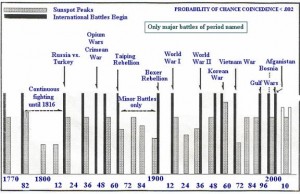Predicting outbreaks of war
Dear Buryl et al;
I read this article with close attention. The assumption of planetary influence on waring and killing is seems irrelevant according to references provided. We may need more scientific researches and study deeper than this.
Of course, in some aspects, the moon and the sun trigger great gravitation on earth, but it seems human’s central gravitation such as greed, hatred and delusion have surpassed that.
Peace,
Sophan Seng
Wars are crazy behavior. When individuals act as crazy as nations or groups and begin killing others, they are locked up as fast as possible, given tranquilizers and other stronger drugs.
Many people believe that ‘warring behavior is just ‘human nature’. ‘Wars are always going on.’ If a person denies such folk wisdom, it’s met with skepticism and rejection. But analysis of the data on wars shows otherwise.
Wars are triggered by sunspots, which are in turn associated with heliocentric planetary positions.
Sunspot data is now available for over two hundred years. Clear cycles have been observed with an average of about 10.3 years.
Alexander Chizhevsky, a Russian scientist, observed that warring behavior was related to sunspot numbers. This was so radical an idea in the Soviet Union that Joseph Stalin put him in jail for over five years!
Raymond Wheeler, a psychologist and historian at the University of Kansas (now deceased), came upon Alexander Chizhevsky’s observations and made further observations. He traced wars back 2,500 years and found war cyc1es in phase with solar cycles. Warring behavior is not a part of human behavior, it is not built in. Warring behavior is not always occurring. It waxes and wanes in a nearly regular fashion.
By careful analysis of Wheeler’s original data I found that the start of wars occurred either when the solar cycle was rapidly rising or rapidly descending; never at the peak.
Bar graph for this is shown in Figure 1. The black bars, representing the start of wars never coincided with the shaded bars representing sunspot peakes. This suggests it was the rate of change (derivative) OF THE SUNSPOT FORMATIONS that was important.
 Figure 1. Sunspot Peaks and Battles.
Figure 1. Sunspot Peaks and Battles.
Previous research had shown that sunspot formations were mostly associated with heliocentric planetary positions.
Read More …


















